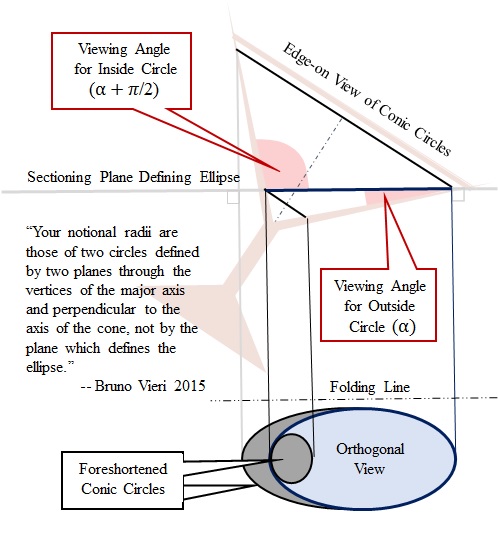|
Copyright ©2015
by Paul Niquette. All rights reserved. |
|
Copyright ©2015
by Paul Niquette. All rights reserved. |
 The sketch draws attention to [deep breath here] the compensating curvature resulting from differences in foreshortening of the osculating circles ("notional radii" in the text above) at opposite ends of the closed curve inscribed upon the sectioning plane by the surface of the cone. For our solution, let us reprise and correct my fallacious explanation for the Ellipse Illusion...
Acknowledgements Permit me to offer an appreciative toast to Rich Alexander, Jürgen Köller, Ed Moore, John Swanson, Bruno Vieri, Leonard Zane for their contributions to the solution page of the Ellipse Illusion...  |
Home Page Puzzle Page Space Stuff The Puzzle as a Literary Genre
|
The
Ellipse as a Conic Section
An ellipse is the boundary formed by
the intersection of a plane with a cone. The example
below shows how the center of the ellipse is NOT the same
as the center of the cone. The general equation for a cone that is
symmetric about the +z-axis is, z = A (x2
+ y2)1/2
and for simplicity set A = 1 The equation for a general plane is, a x + b y + c z
= 1 Again to simplify the analysis,
consider only planes parallel to the x-axis. These planes
intersect the y-z plane in straight lines, z = my + b
and set the z-intercept b
= 1 In order for the plane to cut
completely across the cone, m < |1|
--> and for this example m = ½
--> z = ½ y +
1 The equation for the intersection of
the cone with this plane is found by eliminating z between
the two equations. ½
y + 1 = (x2 + y2)½
--> ¼
y2 + y + 1 = x2
+ y2 --> 1 = x2
+ ¾ (y2–
4/3 y) Complete the square to get, 1 = x2
+ ¾ (y – 2/3)2
– 1/3 --> 4/3 = x2
+3/4 (y – 2/3)2 Re-arranging terms to put into the
canonical form for an ellipse symmetric about the x and
y-axes, 1 = x2
/ (4/3)2 + (y – 2/3)2 /
(16/9)2 This is the equation for an ellipse
with a center at x = 0 and y
= 2/3 with a minor axis of 8/3 and a
major axis of 32/9. |